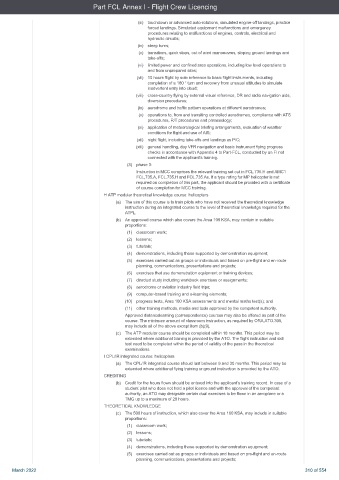Page 310 - UK AirCrew Regulations (Consolidated) March 2022
P. 310
Part FCL Annex I - Flight Crew Licencing
(iii) touchdown or advanced auto-rotations, simulated engine-off landings, practice
forced landings. Simulated equipment malfunctions and emergency
procedures relating to malfunctions of engines, controls, electrical and
hydraulic circuits;
(iv) steep turns;
(v) transitions, quick stops, out of wind manoeuvres, sloping ground landings and
take-offs;
(vi) limited power and confined area operations, including low level operations to
and from unprepared sites;
(vii) 10 hours flight by sole reference to basic flight instruments, including
completion of a 180 ° turn and recovery from unusual attitudes to simulate
inadvertent entry into cloud;
(viii) cross-country flying by external visual reference, DR and radio navigation aids,
diversion procedures;
(ix) aerodrome and traffic pattern operations at different aerodromes;
(x) operations to, from and transiting controlled aerodromes, compliance with ATS
procedures, R/T procedures and phraseology;
(xi) application of meteorological briefing arrangements, evaluation of weather
conditions for flight and use of AIS;
(xii) night flight, including take-offs and landings as PIC;
(xiii) general handling, day VFR navigation and basic instrument flying progress
checks in accordance with Appendix 4 to Part-FCL, conducted by an FI not
connected with the applicant’s training.
(3) phase 3:
Instruction in MCC comprises the relevant training set out in FCL.735.H and AMC1
FCL,735.A, FCL.735.H and FCL.735.As. If a type rating for MP helicopter is not
required on completion of this part, the applicant should be provided with a certificate
of course completion for MCC training.
H ATP modular theoretical knowledge course: helicopters
(a) The aim of this course is to train pilots who have not received the theoretical knowledge
instruction during an integrated course to the level of theoretical knowledge required for the
ATPL.
(b) An approved course which also covers the Area 100 KSA, may contain in suitable
proportions:
(1) classroom work;
(2) lessons;
(3) tutorials;
(4) demonstrations, including those supported by demonstration equipment;
(5) exercises carried out as groups or individuals and based on pre-flight and en-route
planning, communications, presentations and projects;
(6) exercises that use demonstration equipment or training devices;
(7) directed study including workbook exercises or assignments;
(8) aerodrome or aviation industry field trips;
(9) computer-based training and e-learning elements;
(10) progress tests, Area 100 KSA assessments and mental maths test(s); and
(11) other training methods, media and tools approved by the competent authority.
Approved distancelearning (correspondence) courses may also be offered as part of the
course. The minimum amount of classroom instruction, as required by ORA.ATO.305,
may include all of the above except item (b)(9).
(c) The ATP modular course should be completed within 18 months. This period may be
extended where additional training is provided by the ATO. The flight instruction and skill
test need to be completed within the period of validity of the pass in the theoretical
examinations.
I CPL/IR integrated course: helicopters
(a) The CPL/IR integrated course should last between 9 and 30 months. This period may be
extended where additional flying training or ground instruction is provided by the ATO.
CREDITING
(b) Credit for the hours flown should be entered into the applicant’s training record. In case of a
student pilot who does not hold a pilot licence and with the approval of the competent
authority, an ATO may designate certain dual exercises to be flown in an aeroplane or a
TMG up to a maximum of 20 hours.
THEORETICAL KNOWLEDGE
(c) The 500 hours of instruction, which also cover the Area 100 KSA, may include in suitable
proportions:
(1) classroom work;
(2) lessons;
(3) tutorials;
(4) demonstrations, including those supported by demonstration equipment;
(5) exercises carried out as groups or individuals and based on pre-flight and en-route
planning, communications, presentations and projects;
March 2022 310 of 554

